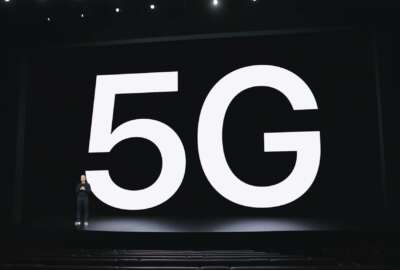New leadership at a group dedicated to helping the government with 5G technology
The National Spectrum Consortium is devoted to R&D related to the emerging 5G and related Internet of Things technologies. Now it has a new executive director, ...
Best listening experience is on Chrome, Firefox or Safari. Subscribe to Federal Drive’s daily audio interviews on Apple Podcasts or PodcastOne.
The National Spectrum Consortium funded by the Defense Department is devoted to R&D related to the emerging 5G and related Internet of Things technologies. Now it has a new executive director with Capitol Hill, Pentagon and industry experience. Dr. Maren Leed joined Federal Drive with Tom Temin in the studio.
Interview transcript:
Tom Temin: Dr. Leed, good to have you on.
Maren Leed: Thanks so much for having me, Tom.
Tom Temin: And let’s begin with the status of the consortium now. You are past the original five-year funding from the Pentagon into a new phase, what’s going on?
Maren Leed: Well, so we were very fortunate to win a new, what is called other transaction agreement, a special kind of contracting authority that is much more flexible than the traditional contract arrangement that really allows our 430-plus members to engage in a very different way with the Defense Department than a traditional contract would allow. So it’s very exciting.
Tom Temin: And these 430 members are a variety of types of organizations aren’t they?
Maren Leed: Our variety is really our strength, right? We have a huge mix of both very large, traditional telecom, we have large traditional defense suppliers, we have very small startups, mostly not in the defense business. And so that’s again, a huge part of our value proposition is bringing those non traditional suppliers into the Defense world in a way that is streamlined and makes it easier for them to gain access to that market and vice versa.
Tom Temin: And where in the Pentagon’s need for future technological capability for future offsets, strength and all of that does the consortium and, more important, the work that it does actually fit?
Maren Leed: Well, so I’d like to think we’re at the center of that, right? The defense leadership is talking about new ways of having to do command and control, being able to leverage the electromagnetic spectrum in dynamic and flexible and agile ways that are sort of unparalleled historically and enabled by the technology that’s really at the centerpiece of what our members do.
Tom Temin: And some of the members provide 5G, I see AT&T is on there, and many of them are resellers or users of it. Now, what is the status of 5G in terms of the work you’re doing? I mean, I’ve got a 5G phone that says 5G when I’m in a metropolitan area, but what is the real status of it? And how is it useful at this point in history?
Maren Leed: I think that’s really what the Defense Department is trying to get out ahead of under the leadership of Dr. Joe Evans and his team in the Office of Research and Engineering in the Defense Department. They’ve sponsored a set of pilot projects at multiple bases across the United States, where they’re looking at what are the Defense Department use cases that also have commercial applications, and pushing the frontier of that technology, both so that it can help advance it for domestic use and consumer use, but also to enable the Defense Department to be more efficient and effective.
Tom Temin: And how does the consortium work? The Pentagon has an idea that it would like to explore, and then it chooses from among the members as to where that particular project award will go?
Maren Leed: Well, the fundamental sort of secret sauce of the consortium, I like to say, is collaboration, right? And it happens in lots of different ways. Collaboration upfront with the consortium members, and the Defense Department says I have a problem. And because we have this flexible agreement in place, they can engage with industry much differently than under a traditional contracting process. So they bring the problem, the consortium members brainstorm with the parts of the department that have a problem, and really, the department gets a very good sense of what the state of technology is. And the consortium members get a really good sense of what the user need is. So that allows the Defense Department to set much better informed requirements than is traditionally the case. And it means that that work gets done very quickly and very effectively. So all of our projects have been on time, on budget and at or above performance requirements, which is kind of unmatched in terms of most Defense Department programs.
Tom Temin: We’re speaking with Dr. Maren Leed, she’s executive director of the National Spectrum Consortium. Give us a couple of examples of recent projects that came out in that manner.
Maren Leed: So a lot of what the consortium has been working on is making spectrum more useful. And in particular, enabling sharing between defense uses and commercial uses more efficient. So getting more out of the spectrum that we’ve got for both sets of users, making it more dynamic, so that we can move away from traditional ways of managing spectrum that are very static and nonflexible – again, greatly enabling more commercial use cases and are kind of essential to 5G, and then also enabling sort of more use cases in ways that can combine both sets of users. So there just was a demonstration of the 5G infrastructure that consortium members have set up to support a logistics base in Albany, Georgia, part of the DoD’s 5G effort, and that used both a combination of DoD-controlled and commercially leveraged spectrum, along with millimeter wave, very efficient 5G spectrum. So that combination allowed for dramatically increased data rates, the ultra low latency that 5G promises in a way that an inside-out private network that really showed the promise of 5G in a way that’s just starting to be deployed commercially, and really sort of showing the way for how this might be done.
Tom Temin: So then, in one sense, ultimately, the government or the DoD could get use of these great technologies, but not be the exclusive user of them and therefore get commercial pricing down the line.
Maren Leed: That dual use, and again, it’s – yes, for defense purposes, but they run warehouses, they run airports, they do a lot of the same businesses, we just have an open proposal right now to look at telemedicine. So lots of dual use cases, where the Defense Department again can get more efficient and effective, and commercial applications get advanced at the same time. There’s a warfighting component to this too, which is an additional effort and requires some modifications to those things. But it’s all informed by the cutting edge tech that we’re developing on a day-to-day basis.
Tom Temin: And one way to see what the Defense Department is interested in is the new working groups that have been set up by the consortium. Just to briefly tell us what those are.
Maren Leed: So those working groups are really an effort for the consortium to kind of move beyond its specific taskings that it’s getting through the other transaction agreement to step more into the strategic competition in commercial standards that is going on between societies that have a much tighter and more controlling relationship between civil and military uses of technology. And –
Tom Temin: Like China, Russia?
Maren Leed: To some degree Europe, even, so again, those government-private relationships differ around the world, and they influence the evolution of commercial standards. And so the NSC is trying to make use of its very unique and broad membership to push standards development into use cases that might not otherwise get considered and help increase the US competitive advantage in standard setting to benefit both industry and our overall strategic competition position.
Tom Temin: And is there a component to the Consortium’s work that involves manufacturing base in the United States?
Maren Leed: Absolutely.
Tom Temin: Because, the whole idea of Chinese equipment is a big an ongoing one.
Maren Leed: So that is absolutely a component of what we do, as is a massive amount of cyber capability internal to the consortium. So we have many members who are again, at the cutting edge of advanced cyber techniques as they apply to some of these new commercial technologies, but ensuring the viability of the supply chain is a key strength of the consortium members.
Tom Temin: And finally, tell us a little bit about yourself. You didn’t come to this from some academic ivory tower.
Maren Leed: I didn’t, I first sort of got into learning about spectrum and it’s – and how imperative it is from spending time in Iraq, actually, I was working for a senior member of the Defense Department who sent me to Iraq.
Tom Temin: Lucky you.
Maren Leed: It actually was lucky me, I was very privileged to get to spend time there and to get to understand and try to bring solutions to service members who were being attacked and killed through electronic warfare. And so the imperative aspect becomes pretty apparent when that’s your day-to-day life, right? So I got to know that community, I got to know that technology a little bit. And then that led to eventually me having a role in being able to stand up the NSC, a very small role, along with a large number of others.
Tom Temin: So you worked for the Pentagon, you also worked on Capitol Hill.
Maren Leed: I did, and not so much in the technology area but in so many of the use cases, I had responsibility for the accounts for logistics, for training for all of these kinds of things that this technology is essential to.
Tom Temin: Dr. Maren Leed is executive director of the National Spectrum Consortium. Thanks so much for joining me.
Maren Leed: Thanks, great to be here and I appreciate the opportunity.
Copyright © 2024 Federal News Network. All rights reserved. This website is not intended for users located within the European Economic Area.
Tom Temin is host of the Federal Drive and has been providing insight on federal technology and management issues for more than 30 years.
Follow @tteminWFED






